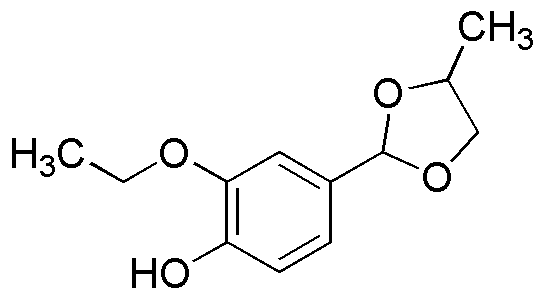Ethyl vanillin propylene glycol acetal is widely utilized in research focused on:
- Flavoring Agents: This compound is commonly used in the food industry as a flavor enhancer. It provides a rich vanilla flavor that is often preferred over natural vanilla due to its stability and cost-effectiveness.
- Fragrance Formulations: In the cosmetics and personal care industry, it serves as a key ingredient in perfumes and scented products, offering a sweet and creamy scent that enhances overall fragrance profiles.
- Pharmaceutical Applications: It is used in the formulation of certain medications, where its flavoring properties help mask unpleasant tastes, making medicines more palatable for patients, especially children.
- Research and Development: In laboratories, it is utilized in the synthesis of various compounds, providing a versatile building block for researchers exploring new chemical reactions and formulations.
- Food Preservation: Ethyl vanillin propylene glycol acetal can act as an antioxidant in food products, helping to extend shelf life by preventing oxidative degradation, which is crucial for maintaining product quality.
General Information
Properties
Safety and Regulations
Applications
Ethyl vanillin propylene glycol acetal is widely utilized in research focused on:
- Flavoring Agents: This compound is commonly used in the food industry as a flavor enhancer. It provides a rich vanilla flavor that is often preferred over natural vanilla due to its stability and cost-effectiveness.
- Fragrance Formulations: In the cosmetics and personal care industry, it serves as a key ingredient in perfumes and scented products, offering a sweet and creamy scent that enhances overall fragrance profiles.
- Pharmaceutical Applications: It is used in the formulation of certain medications, where its flavoring properties help mask unpleasant tastes, making medicines more palatable for patients, especially children.
- Research and Development: In laboratories, it is utilized in the synthesis of various compounds, providing a versatile building block for researchers exploring new chemical reactions and formulations.
- Food Preservation: Ethyl vanillin propylene glycol acetal can act as an antioxidant in food products, helping to extend shelf life by preventing oxidative degradation, which is crucial for maintaining product quality.
Documents
Safety Data Sheets (SDS)
The SDS provides comprehensive safety information on handling, storage, and disposal of the product.
Product Specification (PS)
The PS provides a comprehensive breakdown of the product’s properties, including chemical composition, physical state, purity, and storage requirements. It also details acceptable quality ranges and the product's intended applications.
Certificates of Analysis (COA)
Search for Certificates of Analysis (COA) by entering the products Lot Number. Lot and Batch Numbers can be found on a product’s label following the words ‘Lot’ or ‘Batch’.
*Catalog Number
*Lot Number
Certificates Of Origin (COO)
This COO confirms the country where the product was manufactured, and also details the materials and components used in it and whether it is derived from natural, synthetic, or other specific sources. This certificate may be required for customs, trade, and regulatory compliance.
*Catalog Number
*Lot Number
Safety Data Sheets (SDS)
The SDS provides comprehensive safety information on handling, storage, and disposal of the product.
DownloadProduct Specification (PS)
The PS provides a comprehensive breakdown of the product’s properties, including chemical composition, physical state, purity, and storage requirements. It also details acceptable quality ranges and the product's intended applications.
DownloadCertificates of Analysis (COA)
Search for Certificates of Analysis (COA) by entering the products Lot Number. Lot and Batch Numbers can be found on a product’s label following the words ‘Lot’ or ‘Batch’.
*Catalog Number
*Lot Number
Certificates Of Origin (COO)
This COO confirms the country where the product was manufactured, and also details the materials and components used in it and whether it is derived from natural, synthetic, or other specific sources. This certificate may be required for customs, trade, and regulatory compliance.


